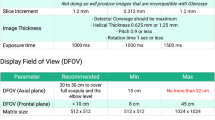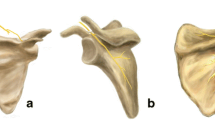Abstract
Purpose
Conventionally, the central structure of the baseplate is inserted through the point where the vertical and horizontal axes of the glenoid intersect (conventional insertion site (CIS)). However, there is scanty theoretical evidence that CIS has the optimal bone stock. We evaluated the optimal insertion site for the glenoid baseplate through the three-dimensional volumetric measurement of the glenoid bone stock.
Methods
Pre-operative computed tomography (CT) images of 30 consecutive reverse total shoulder arthroplasty procedures were analyzed. Three-dimensional image processing software was used to reconstruct CT and volumetrically measure the glenoid bone stock according to the simulated central peg. A simulated central peg was inserted to the medial pole of the scapula from 49 points determined along with the intersect point of the vertical and horizontal axes of the glenoid CIS at 2-mm intervals. The overlapped volume between the simulated central peg and glenoid vault, representing the amount of glenoid bone stock along the passage of the central peg, was then automatically calculated.
Results
The depth of the glenoid vault was 25.5 ± 3.0 mm (range, 19.3–31.5), and the mean overlapped volume between the simulated central peg and the glenoid vault was 623.0 ± 185.8 ml. The optimal insertion site for the bony purchase of the central peg was 2 mm inferior and posterior from the CIS (765.3 ± 157.5).
Conclusion
The optimal insertion site of the baseplate is located slightly inferiorly and posteriorly to the CIS. This anatomical information may be used as a reference to determine the optimal insertion site of the baseplate according to an implant of a surgeon’s choice.





Similar content being viewed by others
Change history
19 January 2022
A Correction to this paper has been published: https://doi.org/10.1007/s00264-021-05297-7
References
Ernstbrunner L, Andronic O, Grubhofer F, Camenzind RS, Wieser K, Gerber C (2019) Long-term results of reverse total shoulder arthroplasty for rotator cuff dysfunction: a systematic review of longitudinal outcomes. J Shoulder Elbow Surg 28:774–781. https://doi.org/10.1016/j.jse.2018.10.005
Favard L, Levigne C, Nerot C, Gerber C, De Wilde L, Mole D (2011) Reverse prostheses in arthropathies with cuff tear: are survivorship and function maintained over time? Clin Orthop Relat Res 469:2469–2475. https://doi.org/10.1007/s11999-011-1833-y
Boileau P (2016) Complications and revision of reverse total shoulder arthroplasty. Orthop Traumatol Surg Res 102:S33-43. https://doi.org/10.1016/j.otsr.2015.06.031
Gutierrez S, Greiwe RM, Frankle MA, Siegal S, Lee WE 3rd (2007) Biomechanical comparison of component position and hardware failure in the reverse shoulder prosthesis. J Shoulder Elbow Surg 16:S9–S12. https://doi.org/10.1016/j.jse.2005.11.008
Codsi MJ, Bennetts C, Gordiev K, Boeck DM, Kwon Y, Brems J, Powell K, Iannotti JP (2008) Normal glenoid vault anatomy and validation of a novel glenoid implant shape. J Shoulder Elbow Surg 17:471–478. https://doi.org/10.1016/j.jse.2007.08.010
Hoenecke HR Jr, Hermida JC, Flores-Hernandez C, D’Lima DD (2010) Accuracy of CT-based measurements of glenoid version for total shoulder arthroplasty. J Shoulder Elbow Surg 19:166–171. https://doi.org/10.1016/j.jse.2009.08.009
Peltz CD, Divine G, Drake A, Ramo NL, Zauel R, Moutzouros V, Bey MJ (2015) Associations between in-vivo glenohumeral joint motion and morphology. J Biomech 48:3252–3257. https://doi.org/10.1016/j.jbiomech.2015.06.030
Hoenecke HR Jr, Hermida JC, Dembitsky N, Patil S, D’Lima DD (2008) Optimizing glenoid component position using three-dimensional computed tomography reconstruction. J Shoulder Elbow Surg 17:637–641. https://doi.org/10.1016/j.jse.2007.11.021
Rispoli DM, Sperling JW, Athwal GS, Wenger DE, Cofield RH (2008) Projection of the glenoid center point within the glenoid vault. Clin Orthop Relat Res 466:573–578. https://doi.org/10.1007/s11999-007-0087-1
Walch G, Badet R, Boulahia A, Khoury A (1999) Morphologic study of the glenoid in primary glenohumeral osteoarthritis. J Arthroplasty 14:756–760. https://doi.org/10.1016/s0883-5403(99)90232-2
Iannotti J, Baker J, Rodriguez E, Brems J, Ricchetti E, Mesiha M, Bryan J (2014) Three-dimensional preoperative planning software and a novel information transfer technology improve glenoid component positioning. J Bone Joint Surg Am 96:e71. https://doi.org/10.2106/jbjs.L.01346
Nashikkar PS, Scholes CJ, Haber MD (2019) Role of intraoperative navigation in the fixation of the glenoid component in reverse total shoulder arthroplasty: a clinical case-control study. J Shoulder Elbow Surg 28:1685–1691. https://doi.org/10.1016/j.jse.2019.03.013
Villatte G, Muller AS, Pereira B, Mulliez A, Reilly P, Emery R (2018) Use of patient-specific instrumentation (PSI) for glenoid component positioning in shoulder arthroplasty. A systematic review and meta-analysis. PLoS One 13:e0201759. https://doi.org/10.1371/journal.pone.0201759
Kriechling P, Roner S, Liebmann F, Casari F, Furnstahl P, Wieser K (2020) Augmented reality for base plate component placement in reverse total shoulder arthroplasty: a feasibility study. Arch Orthop Trauma Surg. https://doi.org/10.1007/s00402-020-03542-z
Cabarcas BC, Cvetanovich GL, Gowd AK, Liu JN, Manderle BJ, Verma NN (2019) Accuracy of patient-specific instrumentation in shoulder arthroplasty: a systematic review and meta-analysis. JSES Open Access 3:117–129. https://doi.org/10.1016/j.jses.2019.07.002
Barrett I, Ramakrishnan A, Cheung E (2019) Safety and efficacy of intraoperative computer-navigated versus non-navigated shoulder arthroplasty at a tertiary referral. Orthop Clin North Am 50:95–101. https://doi.org/10.1016/j.ocl.2018.08.004
Verborgt O, Vanhees M, Heylen S, Hardy P, Declercq G, Bicknell R (2014) Computer navigation and patient-specific instrumentation in shoulder arthroplasty. Sports Med Arthrosc Rev 22:e42-49. https://doi.org/10.1097/jsa.0000000000000045
Jung HJ, Nam T-S, Park D, Jeon I-H (2020) Three-dimensional morphometric analysis of penetrative depth and size of nonarthritic and degenerative arthritic glenoids: implications for glenoid replacement in shoulder arthroplasty. Clin Orthop Surg 12:224–231
Matsuki K, Sugaya H, Hoshika S, Ueda Y, Takahashi N, Tokai M, Banks SA (2018) Three-dimensional measurement of glenoid dimensions and orientations. J Orthop Sci. https://doi.org/10.1016/j.jos.2018.11.019
Cabezas AF, Krebes K, Hussey MM, Santoni BG, Kim HS, Frankle MA, Oh JH (2016) Morphologic variability of the shoulder between the populations of North American and East Asian. Clin Orthop Surg 8:280–287. https://doi.org/10.4055/cios.2016.8.3.280
Dilisio MF, Warner JJ, Walch G (2016) Accuracy of the subchondral smile and surface referencing techniques in reverse shoulder arthroplasty. Orthopedics 39:e615-620. https://doi.org/10.3928/01477447-20160610-04
Author information
Authors and Affiliations
Corresponding author
Additional information
Publisher's Note
Springer Nature remains neutral with regard to jurisdictional claims in published maps and institutional affiliations.
Level of evidence: IV, case series
The original version of this article was revised. The correct copyright should be “The Author(s) under exclusive licence to SICOT aisbl.”
Rights and permissions
About this article
Cite this article
Jeong, H.J., Jeong, M.G., Kim, S.W. et al. Optimal insertion site of glenoid baseplate in reverse total shoulder arthroplasty: anatomical simulation using three dimensional image processing software. International Orthopaedics (SICOT) 45, 3171–3177 (2021). https://doi.org/10.1007/s00264-021-05235-7
Received:
Accepted:
Published:
Issue Date:
DOI: https://doi.org/10.1007/s00264-021-05235-7




